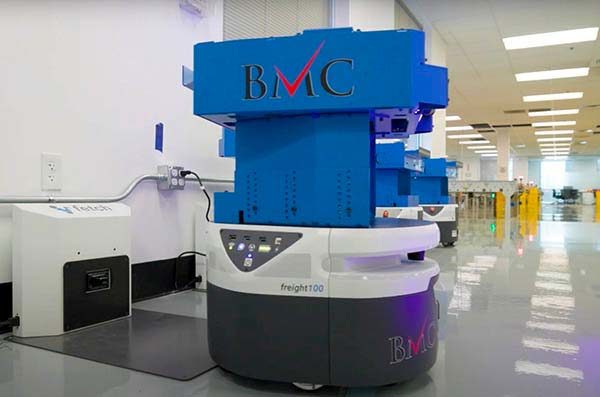Fashion company leaves the “driving” to robots
When it needed to streamline its plant operations last year, apparel company Bespoke “hired” 15 AMRs to move, trace, and direct workpieces to their destinations, freeing human workers for higher-value tasks.

Each year, manufacturers and retailers look for ways to fill customer orders faster and more accurately. Yet all too often, they encounter a host of obstacles—everything from labor shortages to changing industry standards and regulations to ever-tightening timelines—especially during peak season.
These were some of the challenges facing Bespoke Manufacturing Co. (BMC), a manufacturer of primarily high-end women’s wear. Last year, the company was looking to modernize its operations by moving from a traditional “design-make-sell” manufacturing model to an on-demand model. The objectives: to eliminate waste, unify its people and processes, increase efficiency and productivity, and scale up manufacturing operations to meet growing demand.
For help with the project, the company turned to warehouse automation specialist S&H Systems, mobile computing company Zebra Technologies, and Fetch Robotics—a maker of autonomous mobile robots (AMRs) acquired by Zebra in 2021. As BMC explained to its new partners, the end goal was to improve its workflow visibility from the initial printing and cutting of the fabric to the final production phase of packing and shipping.
COMBINING TECH OFFERS NEW POSSIBILITIES
In order to realize its vision, Phoenix-based BMC would need a solution that allowed its front-line workers to focus on production as the company scaled up its on-demand business. The key to that, it concluded, would be delegating its workflow logistics to automated equipment. After weighing various options, the company decided to go with Zebra’s end-to-end industrial and robotics automation solution—which combines the Fetch AMRs with Zebra’s fixed industrial scanners—to help move, trace, and direct workpieces to their destinations along the production line.
“Embracing automation turns inefficient processes into optimal workflows … [in order] to achieve increased accuracy, enhanced throughput, reduced labor needs, faster onboarding of new workers, more data and consistent outcomes, and flexible new solutions,” explained Cody James, strategic account manager at Zebra Technologies/Fetch Robotics, in a webinar.
To design and integrate the automated solution, BMC worked with systems integrator S&H Systems, a member of Zebra’s PartnerConnect program. In the end, BMC deployed 15 of Zebra’s Fetch Robotics RollerTop AMRs (robots with conveyors on top of them) and more than 200 of Zebra’s FS20 and FS40 fixed industrial scanners to move totes throughout the manufacturing process and keep track of them as they work their way through the sewing stations.
THE TRANSFORMATION JOURNEY
The first step in BMC’s manufacturing transformation was to eliminate 90% of the fixed conveyor belts operating throughout its factory. Next, more sewing machines were added to the roughly 50,000-square-foot Phoenix facility. Once the floor space was reconfigured to accommodate the new process, the robots were brought in, the scanners were installed, and technicians began preparing the system to go live.
Today, when a customer orders a piece of clothing online, the order is fed into the company’s enterprise resource planning (ERP) system, which immediately sends instructions to the automated cutting station, where the fabric is cut by a robotic arm. A picker then places the fabric pieces into a bar-coded tote and deposits it on a conveyor. As the tote makes its way down a 50-foot conveyor belt, its bar code is read by a scanner, triggering a process whereby the system identifies what additional items need to be added to the tote—for example, the garment might need a 12-inch zipper, a hook-and-eye, a clasp, and three labels. The tote then travels to an automated vertical material rack (VMR) that will present those additional items (zipper, labels, etc.) to the picker to add to the tote.
Once all the necessary items have been collected, a picker places the tote on a short-line conveyor belt. When the tote reaches its destination, a scanner reads its bar code, which prompts the system to call over an AMR to pick up the tote and autonomously deliver it to as many sewing stations as required. Fixed industrial scanners register the totes at each location, tracking the position of every garment in the plant. Once the order is complete, the robots autonomously deliver the finished goods to packing and shipping stations.
FLEXIBILITY FOR THE FUTURE
Shifting to a highly automated manufacturing operation has been a game changer for BMC. To begin with, the company realized an immediate 33% improvement in space efficiency by removing most of its fixed conveyor belts. This added space now gives BMC the flexibility to accommodate future seasonal demands, explained J. Kirby Best, president and chief executive officer of BMC, in the webinar.
But the benefits didn’t stop there; the company has enjoyed productivity gains as well. The system’s FetchCore Software, which triggers the robots to execute a workflow, can make adjustments to the AMRs’ routes across the plant floor in seconds. According to BMC, the facility has tripled production capacity with the new automated equipment—which allows it to make up to six dresses per minute.
And by producing garments on demand, BMC has eliminated material waste throughout the manufacturing process, minimizing the amount of fabric that ends up in landfills each year.
Most significantly, perhaps, the added flexibility has made a world of difference for employees. The automated systems have streamlined BMC’s workflow processes, allowing workers to focus on picking and hand sewing tasks rather than moving products among 120 different stations. “With Zebra’s unique solution, we are able to realize significant savings in labor time while retaining an ability to instantly scale up to meet seasonal demand surges and seamlessly modify our production,” Best said in a press release.Editor's note: This article was revised on August 28 to correct the location of BMC's factory.
Related Articles
Copyright ©2024. All Rights ReservedDesign, CMS, Hosting & Web Development :: ePublishing